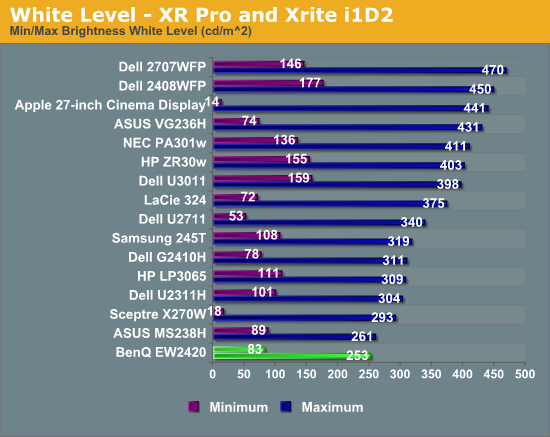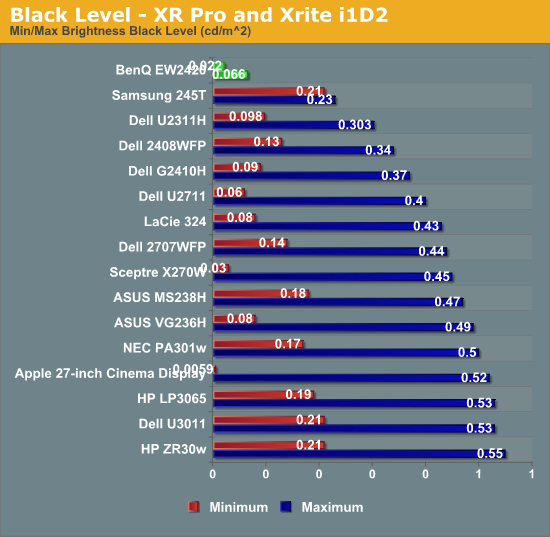BenQ EW2420 Monitor Review
by Chris Heinonen on October 13, 2011 12:00 AM ESTBrightness and Contrast
While the move to an LED instead of a CCFL backlight might mean many things, in the case of the EW2420 it does not mean higher maximum light output. With the backlight and contrast controls at maximum it manages 253 nits of light output. Moving the brightness control down to minimum but leaving the contrast control maximized, the light output falls to 83 nits.

Where the LED backlighting shines is on the light output when displaying a black screen. With the brightness at maximum, the light output with a black screen is only 0.066 nits, and it falls all the way down to 0.022 nits with the brightness at minimum.

What this great black level leads to are superb contrast ratios over 3,800:1 at minimum or maximum brightness, even better than what BenQ specified. This is far more important than the maximum light output since most users will probably use the display somewhere between 100 and 200 nits, and the greater contrast range will be something that you can see. For viewing photos, watching a movie, or playing a game, a higher contrast ratio will make a big difference in the image you can see.

Compared to other displays, the BenQ is far ahead of everyone else. There are other LED lit displays on here, so I’m not sure if it is the combination of the VA panel and the LED lighting, or if they use LED lights with more addressable zones for better light control, or another method. It’s worth nothing that the most advanced LED-backlit televisions can put out a black level below what our test instruments can measure, so monitors still have a little bit further to go with the LED technology, but those sets also are very expensive in comparison.
Brightness Uniformity
With our center measurement at 200 nits, I then measured the light output of a pure white window at nine locations on the screen for the BenQ. While the center and bottom middle locations both are right at that 200 nits level, the light output drops down to the 170-180 nits level at the top of the display.

This is better uniformity than the last display I tested, but it still isn’t quite ideal. Since we disable dynamic contrast, the non-uniform lighting is just a case of the LEDs not being positioned/diffused optimally. The best way to address this is to use rear LED lighting instead of edge LED lighting, but that leads to a far more expensive, and thicker, display than an edge-lit one.

Black uniformity is better than white uniformity. The standard deviation is only 0.007 nits, which is very low. The BenQ is the darkest display I have used on my PC, and it is that way all across the screen.










47 Comments
View All Comments
cheinonen - Thursday, October 13, 2011 - link
The SA750 is on hand and up for review soon, though probably behind a couple of other panels that are already here, one of which is TN.JMS3072 - Thursday, October 13, 2011 - link
Can you speak to the volume of the headphone jack when using high-impedance (32Ω or greater) headphones?cheinonen - Thursday, October 13, 2011 - link
I can't right now but I can try to hook them up tomorrow and give it a quick listen. The headphones I have on hand are 32 ohm (Grado SR60) or AKG K701s that are a huge pain to drive, and I'm certain it won't be able to do a decent job on at all. I will try with the Grado's and see how it does, though. I focused more on the speakers than on the headphone output.cheinonen - Friday, October 14, 2011 - link
I got a chance to hook up my Grado SR60s to the BenQ, playing back a Blu-ray over HDMI. Even with the volume cranked all the way up it really wasn't that loud, much quieter than I would expect. If I had headphones that were hard to drive, I certainly wouldn't count on it putting out a decent volume level.ncomben - Thursday, October 13, 2011 - link
What is it with all these 16:9 monitors - can we have at least have reviews of proper monitors for PC users who do more than just watch films or play console games?I believe the panel makers are doing the public a great injustice in the name of reducing costs and standardising across markets. I can almost understand reviewing below 24" at 16:9 since the headline resolution sounds better than a 16:10 screen much better but at 24", come on...
I'm a developer and, I would argue that the 22" 1680x1050 monitors I am currently using are vastly superior to use than the newer tiny 22" 1920x1080 screens that my company buy for new developers.
I use a 16x10 24" at home for gaming, development, films &, browsing and it's perfect.
We recently got a 27" in the office to try out... it's going back because nobody could read the fonts!
Then again, perhaps it's just me?
cactusdog - Thursday, October 13, 2011 - link
That makes no sense....."I'm a developer and, I would argue that the 22" 1680x1050 monitors I am currently using are vastly superior to use than the newer tiny 22" 1920x1080 screens that my company buy for new developers."
Absolutely no sense when you have less verticle resolution. I'm getting a bit sick of hearing this debate 16:10 vs 16:9, Sure, some people will prefer the extra verticle resolution of 1920x1200 vs 1920x1080 but the ratio argument fails if you prefer a 1680x1050 over a 1920x1080.
Resolution matters, ratio does not. It makes no sense to prefer a smaller res just to get 16:10.
And I agree about testing the SA750/SA950. They are very nice monitors and have better colour reproduction than mainstream IPS monitors.
Rick83 - Thursday, October 13, 2011 - link
The real problem isn't 16:10 or 16:9.the real problem is, that 4:3 and 5:4 are dead, especially in larger than 19 inch screens.
I'm looking for an excellent 1600x1200 screen to get three of, and use them in portrait mode, but it's almost impossible, because the Eizo s2100k is apparently the only high quality display that's not costing an arm and two legs, while still offering reasonably thin bezels and usb-auto-calibration. Sadly, that screen hasn't seen a refresh for more than 6 years, and only old stock is being sold.
At that size and resolution it's also unpractical to go for single displays, and even a good 30 incher is already more expensive - and also going the way of the dodo.
Seems like screen real estate isn't that sought after anymore :(
bobbozzo - Thursday, October 13, 2011 - link
Dell is still selling their 20" model 2007 LCD which is 1600x1200, but it's $399, i.e. the same price as a Dell 1920x1200 24" IPS monitor.imaheadcase - Thursday, October 13, 2011 - link
It does make sense in a personal experience aspect. Once you use a 24inch 1920x1200 using a x1080 just "feels" wrong. You fill ripped off. Games especially. It just feels the screen is tearing.kmmatney - Thursday, October 13, 2011 - link
" I'm getting a bit sick of hearing this debate 16:10 vs 16:9, Sure, some people will prefer the extra verticle resolution of 1920x1200 vs 1920x1080 but the ratio argument fails if you prefer a 1680x1050 over a 1920x1080."Well, you going to keep hearing it - 16:9 sucks. I work in 1920 x 1200, but if I had a choice, I'd pick a 22" 1680 x 1050 screen over 1080p (for work). It makes sense if you spend all day trying to work with the 2 resolutions.